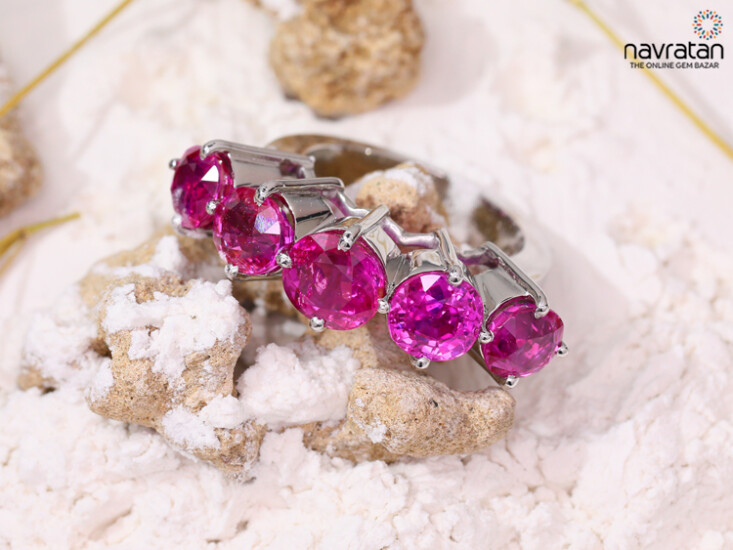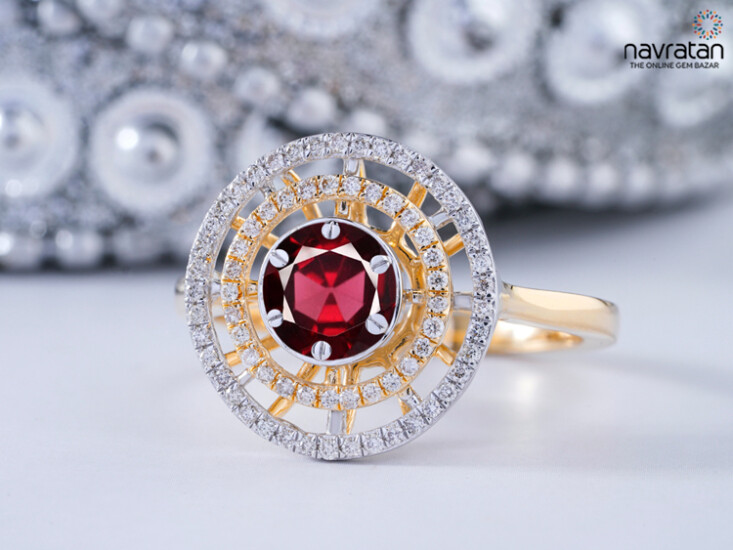 Categories
Categories 
Rubies and garnets are two of the most stupefying, ravishing, and sought-after gemstones with colossal value and humongous popularity. Both are glittering gemstones with paramount astrological significance and extensive implications in the jewelry segment. When two gemstones of mighty stature and extraordinary popularity exist, comparisons are bound to happen and the final verdict has to be delivered.
Though rubies and garnets are both visually brilliant in appearance, they differ by leaps and bounds in terms of color variants, physical properties, durability, value, and popularity. To settle down the debate for once and all, we have carved the most detailed comparison between garnet and ruby stones that will surely help you to figure out which gemstone is exemplary for you and satiate all your intents and purposes. The comparison is done by considering numerous vital factors that are used officially by numerous prominent gem laboratories to evaluate the quality and price of the gemstones. Let’s get started!
Read More:- Substitutes of Ruby

Ruby: Also known as Manik stone, the naturally occurring rubies are majorly found in Thailand and the Salmout District of Columbia. In addition to that, rubies are found in almost all corners of the world with Afghanistan, Namibia, Scotland, India, Brazil, and Japan being the leading sources. In Europe, the republican of Macedonia is the only prime source of par-excellent and naturally occurring rubies. If the fact is considered to be true, rubies from Greenland are said to be the oldest occurring rubies approximately 3 billion years old.
Garnet: This gemstone is primarily found in metamorphic and ingenious rocks, and encloses natural inclusions. If we talk about the major garnet-producing countries, India and Africa top the list. Apart from them, Nigeria, Russia, Sri Lanka, Brazil, Canada, Tanzania, and Madagascar are also noteworthy producers of exalted quality garnet stones. Pure crystals of garnet stones hold immense astrological value and garnet has one of the most extensive and complex family classifications in the realm of gemstones.
Read More:- Red Gemstone Names
Ruby: Ruby belongs to the corundum family and ranks third in the list of the hardest gemstones in existence. Ruby is revered and coveted for its lush red or blood-red color that renders this gemstone a scintillating appearance. The most stable chemical composition of the ruby stone is Al2O3 and due to the presence of traces of Chromium elements, you get to see so many red color variants of ruby stone.

Almost all naturally occurring rubies have impurities and inclusions in them. The concentration of impurities and inclusions determines the quality of a ruby stone. The lesser the inclusions, the better the quality. Not many individuals know that ruby can also exhibit the chatoyancy effect - a phenomenon that is quite prominent in cats’ eye stones.
Garnet: Garnet is one of those rare gemstones that come in all colors with the reddish-brown shade being the most prominent one. Garnet stone comes in highly transparent to semi-opaque and opaque varieties and is used as a prominent abrasive for various industrial purposes.

If we talk about the chemical composition of garnets, they are neo-silicates with the chemical composition X3Y2(SiO4)3. The internal crystal structure of garnet is cubic, hence, when immense pressure is exerted, numerous irregular pieces are formed.
Ruby: Rubies are widely hailed as well as coveted for their drool-worthy and attention-grabbing red color hues. In other words, rubies and red color are synonymous with each other. Whenever people imagine about red color gemstones, the first stone always pops up in their minds is ruby. The orange and yellow hues in rubies are because of the presence of other elements that dwindle their value. The deep red hues in rubies escalate their value to a great extent. In a nutshell, in the world of gemstones, the red color is iconic because of rubies.
Read More:- Timur Ruby - The Comprehensive Guide
Garnets: When it comes to garnets, red and reddish-brown colors are the most sought-after ones as these colors are considered exemplary for jewelry as well as astrological purposes. Garnets are also available in yellow, brown, and pale green colors but they are not revered and valued as much as the red variant. The red color in garnets is because of the presence of iron elements that inculcates during the volcanic forming process.

Ruby: Compared to other gemstones, rubies undergo minimal treatments to enhance clarity, value, and overall appearance. To improve color intensity, rubies have to undergo color alteration. To improve transparency, rubies have to undergo different treatments to remove inclusions. Thus, rubies undergo superficial treatments to make them market ready.
Garnets: Like rubies, garnets also undergo minimal treatment to improve color intensity, clarity, and overall market value. Heat and oiling treatments are often considered to achieve a brilliant appearance in garnets.
Ruby: Ruby is the third hardest gemstone in existence with an astonishing rating of 9 on the Mohs scale. Only diamond and moissanite are harder and more durable than rubies. Thus, when it comes to durability, the ruby stone is miles ahead of the garnet gemstone. That’s one of the key reasons rubies implications are quite extensive in antique and luxury jewelry as they are more resistant to scratch and damage.
Garnet: A garnet stone is relatively less hard than a ruby as it has a rating of 6.5-7.0 on the Mohs scale. If exert immense pressure, garnet jewelry can experience major damage and scratches on the surface. This is one of the factors where garnet falls behind ruby gemstones.
Ruby: This is a no-brainer. Naturally occurring rubies are extremely rare to find and their price can go as higher as a million per carat. However, if we consider the average price figure, the price of ruby begins at $100 per carat and goes up to $10000 per carat. If the origin factor is included, Burmese Rubies are valued and acknowledged the most and their base price is no less than $2000-3000 per carat. The price increases by leaps and bounds with the increase in clarity and color intensity.
Garnet: When it comes to price comparison with ruby, garnet is astronomical miles behind. Due to abundance and seamless availability, garnet stone price is relatively less and could easily be incurred anywhere between $10 per carat and $100 per carat. Ruby emerges as a clear winner in the price category.
We don’t have to elaborate much to state that when it comes to investment purposes, astrological benefit, and amping up appearance, the ruby stone is the numero uno choice for millions. The brilliant and attention-grabbing hues of ruby can enchant anyone and make it one of the most popular choices for gemstone lovers.
On the other hand, garnet tops the affordability pointer and is the perfect alternative to ruby if you have a fettered budget.
It would be daunting even for the most experienced and expert gemologists and astrologers to declare a clear winner between ruby and garnet. People choose on the basis of their needs, budget, and purposes. Ruby offers different sets of benefits and allure while garnet benefits and implications are totally different. Whether you choose a stunning ruby gemstone or a ravishing garnet stone, always choose by considering your zodiac sign and purchase from a credible source like Navratan where you can find a sterling selection of ruby and garnet stones almost in all variations.